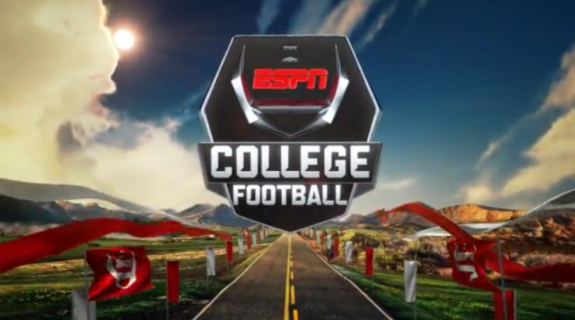The NFL may comprise the elite level of football and sports-watching in this country, but its younger sibling comprises the largest sports franchise in America.
Airing more than 250 games in 2014, ESPN College Football reached a combined total of 185.7 million viewers during its regular-season telecasts alone, according to the National Football Foundation, and 33.4 million more during last season’s inaugural National Championship game between Oregon and Ohio State. And with the introduction of a new college football playoff system, and with sports becoming one of the last live experiences that viewers still want to share as its happening, those numbers for ESPN are only expected to grow in the coming years, reaching a broader, more varied audience than ever before.
Historically, the visual language of televised football in general has fallen somewhere between frat-house and futuristic, dominated by a male-centric visual language of clanking machinery, distressed type and heavy metal music. But college sports fans in general hail from both sides of the gender divide, and the rise of fantasy football has only brought more women into the mix. To reflect these changing trends this viewership, ESPN turned to entertainment branding agency loyalkaspar for a new college football brand identity.
Loyalkaspar’s portfolio isn’t dominated by sports-related projects, but when the company gets one it makes the most of it.
“We try to push the boundaries a little bit and not do what is expected,” said Beat Baudenbacher, the agency’s chief creative officer. An unusually illustrative package loyalkaspar completed for ESPN’s Grantland Basketball Hour (now sadly defunct) last December showcases the mentality.
But for ESPN College Football, loyalkaspar was to tap into that sensibility on an exponentially grander scale, to help the mighty network steer away “from the design crutches that have become commonplace in the college sports landscape,” said ESPN art director Tim O’Shaughnessy. “We referred to it as, ‘breaking away from the foam finger.’”
Dubbed “Football Nation,” the system loyalkaspar proceeded to create breaks down the Unites States into 14 geographical regions, evoking each one with a matte painting specific to the area’s unique landscape.
“We knew we needed to be big in every way possible,” said Baudenbacher, “so we sort of referred to it from the start as the Lord of the Rings of broadcast packages. And when you think of Lord of the Rings, you think of big, epic matte paintings… Peter Jackson doesn’t do depth of field—everything is in focus. It just needed to have that richness, that detail, that scope to really make it feel like the biggest broadcast package on television.”
Within each region’s artwork, different color palettes express three different day parts.
ESPN’s College Game Day begins at 9:00am, during which the landscapes feature a bright blue sky and the crisp greens of a fresh new day. When the afternoon games start to kick in, the chosen landscape changes with it, its shadows growing longer, the sky darkening. Then, of course, night falls.
Within this system of region-specific landscapes, ESPN can now customize team match-ups, pairing any of the NCAA’s 128 schools with the given schools’ associated matte painting. So if the University of Washington were to take on USC, for instance, the mountains and evergreens of the Pacific Northwest could be squared off with the sunny earthiness of southern California with the push of a button. Both schools and their respective landscapes appear on either side of an open road heading into the horizon, beautifully capturing the nation’s epic sweep.

In addition, loyalkaspar designed a new logo system for ESPN College Football, one that uses hard angles to get a little more abstract.
“We wanted something that cuts through and really signals the change,” said Baudenbacher. What ensued is a work of art that recalls both the shape of a football and “some of the shifts that are happening in the vernacular of the uniforms in college football,” he continued. “When you think of the Oregon Ducks, etc. there are a lot of really cool patterns and angles that are happening there… Metallic materials and reflective stuff… We wanted to nod to that vernacular.”
As the year progresses on ESPN College Football, the combinations of logo and landscape change to reflect the narrative arc of the season. Throughout Game Day during the regular season, the arc moves from “daytime matte to nighttime shiny,” said Baudenbacher, “and then through the season itself, from August then through December [and] the playoffs, it’s all in that gold look, magic hour, the signs themselves are now made out of gold elements. The greens are warmer and lusher, the logo itself is now made out of gold. Gold trim with black glass… It’s more light-based in the end, it’s more sparkly, it’s more primetime, it’s more sexy.”
On the screen, it all flows seamlessly and looks perfectly clear and simple no matter what the time of year, though a system with this many detailed moving parts, not to mention pre-built 3D camera moves, is, to put it mildly, “a major undertaking,” said Baudenbacher.
In addition to its conceptual complexities, the system was created using the 3D software NUKE, which ESPN had not previously implemented into its pipeline. A team from the network ended up visiting loyalkaspar’s office to participate in NUKE-specific workshops, and ESPN ultimately did what Baudenbacher estimates to be about 50% of the production, modeling and texturing team signs and sending them to New York so loyalkaspar could light them and integrate them into the landscapes. All in all, the project required more than 80,000 hours of render time.
“The enormity of this project cannot be understated,” said O’Shaughnessy, art director for ESPN. “This was a unique experience in that it required their team and ours, in separate locations, sharing a pipeline and workflows to keep things on task and looking supreme.”
Tags:













































__twocolumncontent.jpg)











